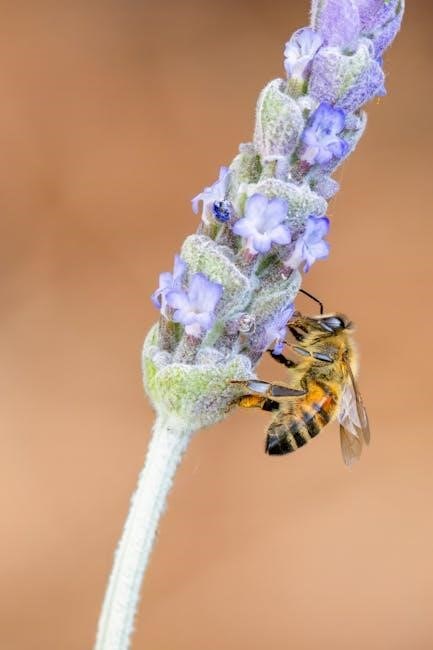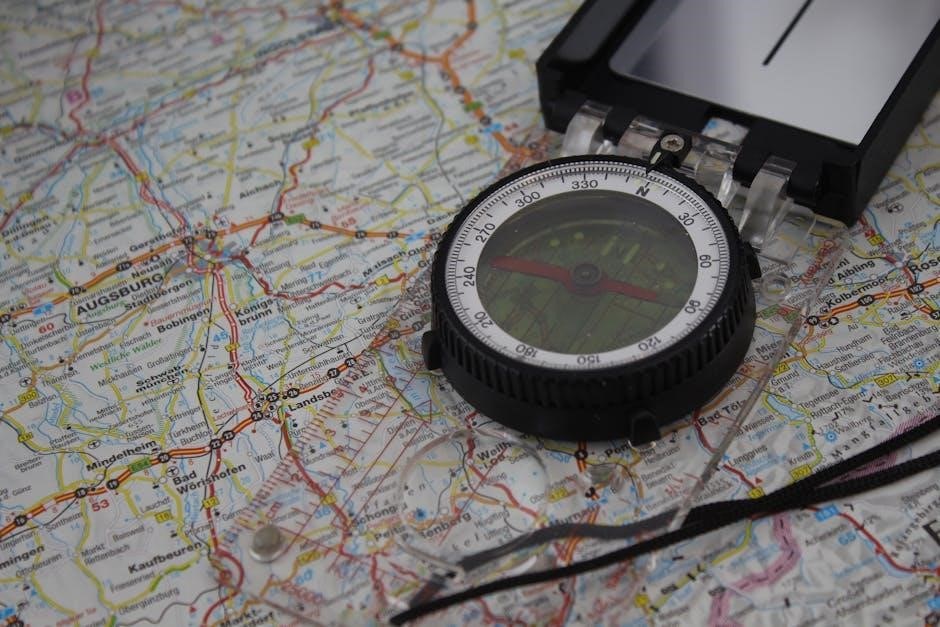Welcome to the South East Queensland Planting Guide! Discover how to thrive in SEQ’s unique climate‚ improve soil health‚ and choose resilient plants for a productive garden․
Understanding the Climate and Soil of South East Queensland
South East Queensland’s subtropical climate features warm‚ humid summers and mild winters․ The region’s diverse microclimates and varying soil types‚ such as sandy‚ clay‚ and loamy soils‚ require tailored planting strategies․ Understanding heat tolerance is crucial‚ as the American Horticultural Society’s heat zone map highlights the area’s high-temperature days․ Soil testing is essential to determine nutrient levels and pH‚ ensuring optimal plant growth․ Maintaining moist soil‚ especially during summer‚ is vital for healthy plant development and preparing for future seasons․
Importance of Seasonal Planting in the Region
Seasonal planting is crucial in South East Queensland due to its distinct climate variations․ Planting crops suited to each season ensures optimal growth and productivity․ During spring‚ focus on vegetables like tomatoes and carrots‚ while summer requires heat-tolerant crops․ Autumn planting prepares the soil for cooler months‚ and winter offers opportunities for hardy vegetables․ Aligning planting schedules with seasonal changes maximizes yields‚ reduces pest risks‚ and enhances soil health‚ making it a cornerstone of successful gardening in the region․
Key Considerations for Beginners
For new gardeners in South East Queensland‚ understanding the local climate and soil is essential․ Start by testing your soil to determine its type and pH levels․ Choose plants adapted to the region’s subtropical climate‚ considering both wet and dry seasons․ Water efficiently and mulch to retain moisture․ Begin with a small‚ manageable garden and gradually expand․ Companion planting can enhance growth and deter pests․ Seek advice from local gardening groups or nurseries to ensure success in your gardening journey․

Climate Zones and Microclimates in South East Queensland
Climate Zones and Microclimates in South East Queensland
South East Queensland spans subtropical and temperate zones‚ with microclimates varying by elevation and coastal proximity․ Coastal areas are cooler‚ while inland and mountainous regions experience greater temperature fluctuations․
Understanding Heat Zones and Plant Tolerance
South East Queensland falls within USDA Plant Hardiness Zones 11 and 12‚ where high temperatures and humidity dominate․ Understanding heat zones is crucial for selecting plants that can tolerate extreme conditions․ Vegetables like tomatoes and capsicum thrive in these zones‚ while native plants such as eucalyptus and banksia are naturally heat-tolerant․ Plant tolerance varies‚ so choosing varieties bred for resilience is key․ This ensures healthy growth and productivity‚ even during the region’s intense summer months․
Identifying Microclimates in Your Garden
In South East Queensland‚ gardens often have distinct microclimates shaped by topography‚ vegetation‚ and structures․ Lower areas may retain moisture‚ while higher spots stay drier․ Slopes facing north receive more sunlight‚ while south-facing slopes are cooler․ Trees and shrubs create shaded‚ humid microclimates‚ preserving soil moisture․ Structures like walls can block winds or trap heat․ Paved areas absorb heat‚ increasing local temperatures․ Soil types and mulching practices also influence microclimates by affecting water retention and temperature․ Observing these variations helps gardeners tailor plant selection and care‚ enhancing overall garden resilience and productivity․
How to Create a Resilient Garden in Variable Conditions
A resilient garden in South East Queensland thrives by adapting to the region’s unpredictable weather․ Start by selecting plants native to the area‚ as they are inherently suited to local conditions․ Diversify your plantings to ensure a range of species can withstand different stresses․ Incorporate mulch to retain soil moisture and regulate temperature․ Use compost and organic matter to improve soil structure‚ enhancing water retention and nutrient availability․ Implement efficient irrigation systems and water deeply but infrequently to encourage deep root growth‚ making plants more drought-tolerant․ Regularly monitor and prune plants to maintain health and airflow‚ reducing disease risks․ By combining these strategies‚ your garden becomes better equipped to handle variability in weather patterns‚ ensuring long-term productivity and beauty․
Soil Preparation and Management
Soil Preparation and Management
Proper soil preparation is crucial for a thriving garden․ Test soil pH‚ add organic matter‚ and mulch to retain moisture and suppress weeds effectively․
Testing and Enhancing Soil Quality
Testing soil pH levels is essential to determine acidity or alkalinity‚ as different plants thrive in specific ranges․ Conducting a soil test provides insights into nutrient deficiencies․ Enhance soil quality by incorporating compost‚ manure‚ or organic matter to improve structure and fertility․ Balancing nitrogen‚ phosphorus‚ and potassium levels ensures optimal plant growth․ Regular mulching retains moisture‚ suppresses weeds‚ and gradually enriches the soil․ These practices promote a healthy‚ productive garden tailored to South East Queensland’s unique conditions and climate challenges․
Best Practices for Maintaining Moist Soil
Maintaining moist soil is crucial for healthy plant growth in South East Queensland’s climate․ Mulch heavily to retain moisture and suppress weeds․ Use drip irrigation for efficient water delivery․ Water deeply but infrequently to encourage deep root growth․ Apply organic matter like compost to improve soil water-holding capacity․ Avoid over-tilling‚ as it can disrupt soil structure․ Shade cloth can protect soil from intense sunlight during summer․ Regularly monitor soil moisture by checking its consistency․ These practices ensure consistent hydration‚ supporting robust plant development throughout the region’s varied seasons․
Using Companion Planting to Improve Soil Health
Companion planting is a sustainable way to enhance soil health in South East Queensland gardens․ Certain plants‚ like legumes‚ add nitrogen to the soil‚ while others repel pests or attract beneficial insects․ Marigolds deter nematodes‚ while nasturtiums repel aphids․ Comfrey acts as a “fertilizer plant‚” adding organic matter․ Planting diverse species together reduces soil-borne diseases and improves nutrient cycling․ This method minimizes the need for chemical fertilizers and pesticides‚ creating a balanced ecosystem․ Rotate plants seasonally to maintain soil fertility and structure‚ ensuring long-term garden productivity․

Choosing the Right Plants for Your Garden
Choosing the Right Plants for Your Garden
Selecting plants suited to South East Queensland’s subtropical climate ensures thriving growth․ Native species‚ vegetables‚ and flowers that tolerate heat and humidity create a resilient garden․
Vegetables Suitable for South East Queensland
South East Queensland’s subtropical climate supports a wide range of vegetables․ Leafy greens like spinach and kale thrive in cooler months‚ while tomatoes‚ cucumbers‚ and capsicums excel in warmer weather․ Root vegetables such as carrots and sweet potatoes grow well in well-drained soil․ Zucchini‚ eggplant‚ and beans are ideal for summer gardens․ Tropical varieties like okra and malabar spinach also perform exceptionally․ Planting seasonal crops ensures optimal growth‚ as the region’s warm‚ humid conditions favor vegetables that tolerate heat and high moisture levels․ Selecting varieties resistant to pests and diseases further enhances success in this climate․
Herbs and Flowers for Urban Gardens
South East Queensland’s climate is ideal for growing a variety of herbs and flowers in urban gardens․ Herbs like basil‚ mint‚ and rosemary thrive in the warm‚ humid conditions‚ while flowers such as geraniums‚ marigolds‚ and lavender add color and attract pollinators․ These plants are perfect for small spaces‚ including balconies and courtyards․ Many varieties are low-maintenance and can tolerate the region’s seasonal changes․ Incorporating these plants enhances biodiversity‚ improves air quality‚ and creates a vibrant‚ welcoming environment․ They also pair well with vegetables‚ promoting a balanced and thriving urban garden ecosystem․
Plants That Attract Pollinators
Attracting pollinators like bees‚ butterflies‚ and birds is vital for a thriving garden․ Native plants such as Banksia‚ Grevillea‚ and Bottlebrush (Callistemon) are excellent choices‚ as they naturally attract pollinators with their vibrant flowers․ Herbs like lavender and rosemary also serve as great pollinator magnets․ Incorporating these plants into your garden fosters biodiversity and supports local wildlife․ By creating a pollinator-friendly environment‚ you enhance the health and productivity of your garden‚ ensuring a balanced ecosystem that benefits both plants and wildlife alike․

Seasonal Planting Guide

Seasonal Planting Guide
Align planting with South East Queensland’s seasons for optimal growth․ Spring: vibrant flowers and vegetables․ Summer: heat-tolerant crops․ Autumn: prepare for cooler months․ Winter: hardy plants thrive․ Always check local climate guides for precise timing․
Spring Planting: What to Grow and When
Spring in South East Queensland is ideal for planting vibrant vegetables and flowers․ Tomatoes‚ cucumbers‚ and herbs like basil thrive in the warmer weather․ Plant zucchini‚ carrots‚ and beans in early spring for a bountiful harvest․ Marigolds and sunflowers add color to gardens․ Ensure soil is well-prepared with compost‚ and choose varieties resistant to pests․ Plant seedlings in late winter to early spring for optimal growth․ Keep the soil moist but not waterlogged‚ as spring rains can be unpredictable․ This season is perfect for establishing a diverse and productive garden․
Summer Planting: Heat-Tolerant Crops
Summer in South East Queensland is perfect for growing heat-tolerant crops like tomatoes‚ zucchini‚ and capsicum․ Sweet potatoes‚ pumpkins‚ and corn also thrive in the warm weather․ Herbs such as basil and chillies excel in summer conditions․ Choose varieties bred for high temperatures and humidity․ Plant seedlings in late spring to early summer for optimal results․ Ensure soil remains fertile with compost and mulch to retain moisture․ Regular watering is essential‚ but avoid overwatering to prevent root rot․ Summer planting offers a wide range of flavorful and nutritious options for gardeners in the region․
Autumn Planting: Preparing for Cooler Months
Autumn in South East Queensland offers ideal conditions for planting cool-season crops like broccoli‚ spinach‚ and carrots․ This season is perfect for sowing root vegetables such as beets and radishes․ Planting brassicas like kale and cabbage also thrives in autumn’s milder temperatures․ Incorporate compost or manure to replenish soil nutrients․ Autumn planting allows for a head start on the next growing season‚ with many crops maturing before winter frosts․ Additionally‚ autumn gardens benefit from fewer pests and diseases compared to summer‚ making it an excellent time to refresh your garden with fresh greens and root vegetables․
Winter Planting: Hardy Vegetables and Flowers
In South East Queensland‚ winter offers a great opportunity to grow hardy vegetables like spinach‚ lettuce‚ and kale‚ which thrive in cooler conditions․ Root vegetables such as carrots and beets also perform well․ For flowers‚ pansies‚ violas‚ and snapdragons add vibrant colors to winter gardens․ Herbs like parsley and thyme can be planted too․ Ensure soil is well-prepared with compost to maintain fertility․ Winter planting allows for a fresh harvest before spring arrives‚ making it an ideal time to refresh your garden with resilient crops and blooms․

Companion Planting Guide

Companion Planting Guide
Companion planting enhances growth‚ deters pests‚ and improves flavor by strategically pairing plants․ It promotes biodiversity and balances nutrients in South East Queensland gardens effectively․
Benefits of Companion Planting
Companion planting offers numerous benefits‚ including improved plant growth‚ enhanced flavor‚ and natural pest control․ It reduces the need for chemicals by deterring harmful insects and attracting beneficial ones․ This method also promotes soil health by balancing nutrients and preventing depletion․ In South East Queensland’s subtropical climate‚ companion planting helps plants thrive by creating shade‚ retaining moisture‚ and supporting pollination․ It encourages biodiversity and maximizes garden space efficiently․ By fostering a balanced ecosystem‚ companion planting supports sustainable and productive gardening practices for both experienced growers and beginners alike in the region․
Best Combinations for Vegetables and Flowers
In South East Queensland‚ pairing vegetables with complementary flowers enhances growth and pest resistance․ Marigolds with tomatoes deter nematodes and attract pollinators․ Basil and roses improve flavor and repel pests like aphids․ Nasturtiums planted near cucumbers attract beneficial insects and reduce aphid infestations․ Radishes paired with cucumbers repel cucumber beetles‚ while sunflowers with lettuce provide shade and attract pollinators․ These combinations optimize space‚ improve soil health‚ and create a balanced ecosystem‚ making them ideal for the region’s subtropical climate․
Plants to Avoid Growing Together
In South East Queensland‚ certain plants should not be grown together due to competition or pest attraction․ Tomatoes and fennel hinder each other’s growth‚ while onions and beans should be separated to avoid stunted development; Potatoes and tomatoes‚ both from the nightshade family‚ can share diseases․ Cucumbers and potatoes should not be planted together to prevent pest issues․ Similarly‚ carrots and dill can interfere with growth․ Avoiding these combinations ensures healthier plants and reduces disease risks‚ promoting a balanced garden ecosystem in the region’s climate․

Garden Design and Space Optimization
Optimize your garden by maximizing vertical space with trellises and layers․ Use rainwater collection and native plants to enhance sustainability․ Ensure proper sunlight distribution for healthy growth․
Maximizing Space in Small Gardens
In South East Queensland‚ small gardens can thrive with clever space-saving techniques․ Use vertical gardening with trellises‚ arbors‚ or wall-mounted planters to grow vining plants like tomatoes or peas․ Layer plants by height‚ placing taller varieties like sunflowers at the back and shorter herbs or leafy greens at the front․ Incorporate multi-level raised beds or containers to maximize ground space․ Opt for compact or dwarf plant varieties bred for small spaces․ Proper soil preparation and efficient watering systems‚ like drip irrigation‚ further enhance productivity in tight areas․
Creating Raised Garden Beds
Raised garden beds are ideal for South East Queensland gardens‚ improving drainage and soil quality․ Use durable materials like untreated wood‚ metal‚ or recycled plastic for frame construction․ Beds should be 1-1․2 metres wide for easy access and 0․2-0․3 metres high to enhance root growth․ Line the base with gravel or mesh for drainage․ Fill with a mix of compost‚ manure‚ and garden soil․ Edging plants like herbs or flowers can add beauty and functionality․ Regularly top up soil and mulch to maintain fertility and structure;
Incorporating Pollinator Habitats
Incorporating pollinator habitats into your South East Queensland garden supports biodiversity and plant health․ Plant native flowers like grevilleas and eucalyptus‚ which attract bees and butterflies․ Include a mix of annuals and perennials to provide constant nectar sources․ Avoid pesticides to protect pollinators and opt for natural pest control․ Add water sources‚ such as shallow dishes with fresh water‚ to sustain pollinators․ Create sunny spots‚ as many pollinators thrive in warmth․ Native shrubs and groundcovers also provide shelter and food‚ enhancing your garden’s ecosystem and productivity․
Pest and Disease Management
Pest and Disease Management
Monitor plants regularly for pests and diseases common in South East Queensland․ Use organic controls and maintain healthy soil to prevent outbreaks and promote resilience․
Natural Methods to Deter Pests
Natural pest control methods are essential for maintaining a healthy garden in South East Queensland․ Introduce beneficial insects like ladybugs and lacewings to prey on common pests such as aphids‚ caterpillars‚ and mites․ Organic repellents‚ such as neem oil‚ garlic spray‚ and mild soap solutions‚ can effectively deter pests without harming plants․ Physical barriers‚ like fine mesh or copper tape‚ can also prevent pests from reaching your crops․ Companion planting with pest-repellent herbs and flowers‚ such as basil‚ marigolds‚ and nasturtiums‚ enhances garden health naturally․ Regularly inspect plants and maintain cleanliness to prevent pest infestations․
Common Diseases in South East Queensland
South East Queensland’s subtropical climate fosters conditions for various plant diseases․ Root rot‚ caused by overwatering‚ is prevalent in moist soils․ Leaf spot and powdery mildew thrive in humid environments‚ affecting foliage․ Collar rot and stem blight often target young plants․ Regularly inspecting plants‚ improving air circulation‚ and avoiding overhead watering can prevent these issues․ Crop rotation and using disease-resistant varieties also help minimize the risk of infection․ Early detection and treatment are crucial to safeguarding plant health in this region․
Organic Solutions for Healthy Plants
Organic solutions are essential for maintaining healthy plants in South East Queensland’s climate․ Compost tea promotes soil health and strengthens plant immunity․ Neem oil and diatomaceous earth are effective natural pesticides for controlling pests․ Introducing beneficial insects‚ like ladybugs‚ helps balance garden ecosystems․ Mulching retains moisture and suppresses weeds․ Regularly adding organic matter‚ such as worm castings or well-rotted manure‚ enhances soil fertility․ These eco-friendly practices ensure plants thrive without chemical inputs‚ fostering a sustainable and resilient garden environment․
Watering and Irrigation Tips

Watering and Irrigation Tips
Efficient watering is crucial in South East Queensland․ Use drip irrigation for water conservation․ Apply mulch to retain moisture and reduce evaporation․ Avoid overwatering to prevent root rot and nutrient leaching․ Water deeply but infrequently to encourage deep root growth․ Monitor soil moisture by checking the first few inches of soil․ Early morning watering reduces evaporation and minimizes fungal diseases․ Use rainwater where possible to maintain soil health and reduce reliance on mains water․
Efficient Watering Techniques
For South East Queensland gardens‚ efficient watering techniques are essential to conserve water and support plant health․ Use drip irrigation to deliver water directly to roots‚ minimizing evaporation․ Apply a 5-10 cm layer of organic mulch to retain soil moisture and suppress weeds․ Water deeply once or twice a week‚ encouraging deep root growth․ Avoid frequent shallow watering‚ which can lead to weak root systems․ Check soil moisture by inserting a finger into the soil up to the knuckle․ Water in the early morning to reduce evaporation and fungal diseases․ Use rainwater where possible for a natural‚ chemical-free option․
Managing Soil Moisture During Summer
During South East Queensland’s hot‚ humid summers‚ managing soil moisture is crucial to prevent water stress in plants․ Regularly monitor soil by digging a small test hole to check moisture levels․ Apply a thick layer of mulch to shield soil from direct sun and reduce evaporation․ Water deeply but infrequently to encourage deep root growth․ Use soil conditioners like compost or manure to improve moisture retention in sandy soils․ Avoid overhead watering during peak sun hours to minimize evaporation․ Consider using shade cloth or row covers for sensitive plants during extreme heatwaves․
Slow Evaporation Methods
Slow evaporation methods are essential for water conservation in South East Queensland’s dry summers․ Use mulch like organic straw or bark chips to cover soil‚ reducing water loss․ Incorporate water-storing gels or crystals into soil to release moisture as plants need it․ Drip irrigation systems deliver water slowly and directly to roots‚ minimizing runoff․ Shade cloths can also protect soil from intense sunlight‚ slowing evaporation․ These techniques ensure plants receive consistent moisture without overwatering‚ making them ideal for the region’s climate․ Regular monitoring ensures these methods remain effective throughout the growing season․

Troubleshooting Common Issues
Troubleshooting Common Issues
Identify and address issues early to ensure garden health․ Check for pests‚ nutrient deficiencies‚ or water stress․ Use organic treatments and adjust watering schedules as needed․
Identifying and Solving Soil Problems
Soil issues in South East Queensland often stem from acidity‚ nutrient deficiencies‚ or poor drainage․ Test your soil regularly to determine pH levels and nutrient content․ Add organic matter like compost or manure to improve soil structure and fertility․ For sandy soils‚ incorporate mulch to retain moisture and suppress weeds․ In heavy clay soils‚ mix in sand or perlite to enhance drainage․ Addressing these problems early promotes healthy root development and robust plant growth‚ ensuring your garden thrives in the region’s unique conditions․
Addressing Pest Infestations
Pest infestations in South East Queensland gardens can be managed naturally by introducing beneficial insects like ladybugs or lacewings․ Regularly inspect plants for signs of damage‚ and hand-pick pests like caterpillars or aphids․ Use physical barriers‚ such as fine mesh‚ to protect young plants from insects․ Organic sprays like neem oil or garlic solutions can effectively control outbreaks․ Maintain healthy soil and diverse plantings to encourage a balanced ecosystem․ Avoid overusing pesticides‚ as they harm beneficial insects․ Early detection and integrated pest management strategies are key to minimizing damage and promoting long-term garden health․
Recovering from Weather Damage
After severe weather‚ inspect your garden for damage‚ focusing on broken branches and uprooted plants․ Prune damaged areas to promote healing and prevent rot․ Remove debris to prevent fungal growth and pests․ Replant in the next suitable planting season‚ ensuring soil health is restored․ For soil erosion‚ apply mulch or groundcovers to stabilize areas․ Check irrigation systems for damage and adjust watering schedules․ Protect young plants with stakes or shelters if needed․ Focus on restoring soil health with organic matter to support recovery and future resilience․
With these insights‚ you’re ready to create a thriving garden․ Explore local nurseries‚ online guides‚ and gardening communities for continuous learning and a bountiful harvest․
Final Tips for a Successful Garden
Observe your garden’s unique conditions and adapt planting strategies accordingly․ Regularly monitor soil moisture‚ especially during hot months․ Incorporate compost and mulch to enrich soil and retain water․ Rotate crops annually to prevent soil depletion and pest buildup․ Encourage pollinators by planting a mix of flowers and herbs․ Keep a gardening journal to track progress and plan future plantings․ Stay vigilant about pests and diseases‚ addressing issues early to protect your harvest․ With patience and consistent care‚ your South East Queensland garden will thrive year-round․
Recommended Reading and Tools
For further guidance‚ explore local gardening guides and online resources tailored to South East Queensland․ Utilize tools like soil testing kits‚ gardening apps‚ and weather trackers to optimize your planting schedule․ Invest in durable gardening tools such as quality shovels‚ gloves‚ and irrigation systems․ Consider subscribing to gardening magazines or joining local gardening groups for shared knowledge and tips․ These resources will empower you to make informed decisions and enhance your gardening experience in the region․

